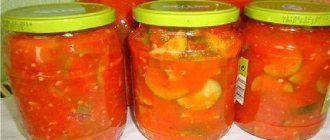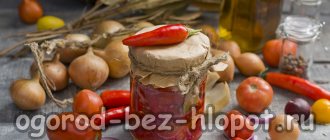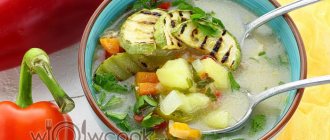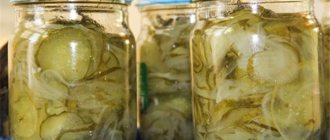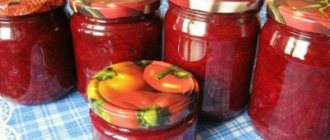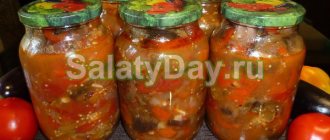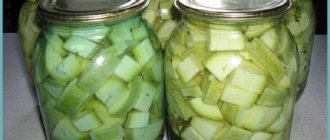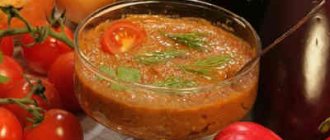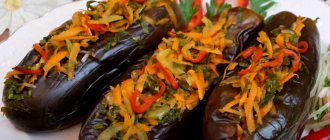Often the taste and aroma of a dish are determined not so much by the set of main ingredients as by the choice of cooking method and the kitchen utensils used. So, for example, a traditional Armenian salad of baked vegetables turns out to be completely different from any other dish made from similar products.
Today the portal “Your Cook” will share with you the main secrets of preparing this dish and tell you about the two most successful methods of making it.
Tips for preparing traditional Armenian salad
If we consider the salad appetizer from the point of view of the ingredient composition, we can find out that the Armenian salad is, in fact, a classic vegetable dish with the main ingredient – eggplant.
Its peculiarity is that all the vegetables for this wonderful salad are not pickled and not served raw. Moreover, they are not fried - they are baked. Thanks to this, the vegetables are soft, but at the same time retain their shape.
In addition, this method of heat treatment of products makes it possible to make them as healthy as possible. They retain more vitamins and microelements, and their taste itself is special.
Let's look at the basic recommendations for preparing this wonderful national dish.
- It is extremely important to ensure that the oven is sufficiently warm when placing vegetables in the oven. Typically, products for an Armenian salad are baked at 200 degrees for half an hour to an hour. The time directly depends on the size of the vegetable and its type.
- It is very easy to determine the readiness of vegetables: if the tines of a fork enter them easily, it means that they are already soft enough inside and can be removed from the oven.
- To prevent the vegetables from burning, pour a little water (no more than half a glass) into the bottom of the pan in which they will be baked.
- All ingredients, including onions, are always cooked with their skins on. This is done regardless of whether we are talking about cooking in the oven or over an open fire. Thanks to the skin, vegetables retain their shape and juiciness.
- Most of the vegetables for this dish have a sweetish taste. That is why dressing for Armenian salad should be slightly sour and spicy. To do this, add vinegar or lemon juice, as well as more garlic.
- The selection of greens for this salad appetizer is also important. Traditionally, cilantro is used. However, if you prefer classic herbs without a specific flavor, you can use the usual combination - dill, parsley and green onions.
- If you do not plan to prepare a completely vegetarian dish, you can diversify it a little by adding pickled cheeses. Cheese cheese and classic feta are perfect here.
You can reduce the cooking time for vegetables by using foil, but the consistency of the salad will be more mushy.
The recipe for the oven is suitable for those who simply want to please themselves and loved ones with aromatic national food. The method involving the use of a barbecue will be a good find for those who love barbecue. Baked vegetables go well with meat and complement it wonderfully as a side dish.
Parsley
Parsley (Petroselinum) is a small plant of the Apiaceae family, a close relative of carrots and parsnips.
Use
Parsley leaves are one of the most common spices in the world.
Fresh and dried parsley leaves are added to salad, sandwich, pie, pizza, spaghetti, thick soups, vegetable, meat and fish soup.
Curly parsley in some cases acts as a garnish.
Parsley holds up well to freezing and can usually be stored for a whole year.
The most successful combination of parsley with potatoes, rice, and meat.
A decoction of young parsley is used for cosmetic purposes as a remedy for acne and wrinkles and as a tonic for every skin type.
The roots of leaf parsley are relatively thin and tough, so their use is usually limited to soups and broths.
Parsley, along with parsnips, celery root and onions, adds fragrance, flavor and nutritional value to thick soups and broths.
Classic recipe for oven-baked vegetable salad from Armenia
Ingredients
- Onions – 4 heads + –
- Medium-sized tomatoes - 5 pcs. + —
- Bell pepper - 4 pcs. + —
- Eggplants - 3 pcs. + —
- Garlic – 5-6 cloves + –
- Cilantro – 1 bunch + –
- Lemon - 1/2 pcs. + —
- Olive oil – 100 ml + –
- Pepper mixture - to taste + -
- Salt - a pinch + -
Add all
to shopping list
Remove everything
from shopping list Shopping list
How to properly bake Armenian vegetable salad in the oven step by step
Before we start preparing vegetables, we immediately set our oven to warm up. The temperature in it must be 200 degrees when we finish with the food.
- We rinse all vegetables, but do not peel them. We set them aside and deal with the bell peppers. You can remove the seeds later, but this will complicate the cooking process. So we cut off the “caps” in advance and remove the seeds from the vegetables.
- We also cut off the “butts” of the eggplants and pierce the skin with a fork in several places.
- Pour a little water into two baking dishes, put tomatoes and peppers in one of them, and onions and eggplants in the other. We put it in the oven.
- During baking, turn the vegetables once for more even baking. After half an hour, take out the baking sheet with peppers and tomatoes.
- We check the readiness of the eggplants with a fork; if necessary, keep them in the oven for up to an hour. Then take it out and let it cool a little.
- We are preparing the dressing. Pour olive oil into a small bowl, add salt and pepper and squeeze the garlic cloves through a press. Then add the washed and finely chopped cilantro, and also squeeze the juice from half a lemon. Mix everything well and let it brew a little.
- We clean the onions and chop them as finely as possible. Cut the eggplants into cubes, divide the tomatoes into several parts. We chop the peppers into strips.
- Pour all the vegetables into a salad bowl, pour in the dressing and mix well. Let our Armenian masterpiece stand for about 10 minutes, after which the salad can be served.
If you do everything quickly, the salad will turn out warm. If you are not a fan of warm salad appetizers, you can put the bowl of food in the refrigerator for half an hour before serving.
Cilantro
Coriander (Coriandrum sativum)
Description
Cilantro is a spicy-aromatic annual plant of the Apiaceae family.
In cooking, fresh and dried herbs are used (this is what is called cilantro), as well as dried grains, both whole and ground (they are already called coriander).
Young leaves have a slightly bitter taste and a sharply spicy aroma. The dried beans have a distinctly delicate aroma of anise and citrus.
Story
Cilantro became popular over 5,000 years ago. At first it was used in medicine, and then it came to the taste of culinary specialists.
The ancient Egyptians placed coriander in the stone tombs of the pharaohs; the ancient Chinese believed that it made a person eternal; in the Middle Ages, coriander grains were added to romantic magic potions, and in Southeast Asia it is still traditionally credited with stimulating properties.
The noble Romans used cilantro to awaken a truly ravenous appetite.
Cilantro appeared in Russia relatively recently - in 1830 it was brought by the Russian Count Apraksin, who visited Spain.
Use
Sufficiently young green cilantro is used in salads, and also as a seasoning for thick soups and meat dishes.
Coriander grains are an excellent spice for flavoring fatty cheese, sausages, canned food, homemade pickles, liqueurs and certain types of beer.
Chewing coriander seeds slows down the hopping process and reduces the smell of consumed alcohol.
Coriander contains a significant number of essential oils, which in alcoholic tinctures add fragrance and reduce the annoying properties of consumed alcohol.
An extract of essential oils from coriander grains is used in the recipes of some brands of gins.
Borodinsky bread, generously sprinkled with coriander seeds, has long been widely popular in Russia.
Recipe for Armenian salad from charcoal-roasted vegetables
In this recipe we will make an Armenian salad on the grill. As noted above, this option is perfect for those looking for a side dish option for barbecue.
Ingredients
- Eggplants – 3 pcs.;
- Table vinegar – 1 tbsp;
- Sunflower or olive oil – 4 tbsp;
- Tomatoes – 4 pcs.;
- Garlic – 5 cloves;
- Sweet red pepper – 2 pcs.;
- Cilantro – 1 bunch;
- Salt and pepper mixture - to taste;
- Onions – 3 heads.
How to make an Armenian salad appetizer from grilled vegetables with your own hands
- We wash all the vegetables well under running water and cut off the “butts” from the eggplants.
- Cut out the seeds from the peppers and remove the caps.
- We skewer all the vegetables (we pierce the peppers diagonally so that the skewer penetrates two walls). Place the skewers on the grill so that the vegetables are above the coals.
- Fry them on all sides until a characteristic baked crust appears on the entire surface.
- Remove the vegetables from the skewers and let cool slightly. If desired, remove the skins from the tomatoes. Be sure to remove the skins from the onions.
- Chop all the products randomly, but not too finely, otherwise you will get a homogeneous mass.
- Place all the cuttings in a salad bowl, pour in vegetable oil and vinegar. We also add all the spices, salt and finely chopped garlic cloves and cilantro.
- Mix everything well, let it sit for about five minutes and savor it along with the aromatic kebab.
This Armenian salad of baked vegetables will be an excellent addition to any table, even if there is no kebab nearby. By the way, pieces of boiled or baked beef can be chopped and added to a bowl for an appetizer - you will get a full-fledged, satisfying dish.
Dill
Description
Dill (Anethum graveolens) is a spicy annual plant, cold-resistant, whimsical.
It has an erect, rounded stem with an average height of up to 90 cm, pinnately dissected, thread-like leaves.
Blooms profusely in June-July, producing multi-flowered umbels.
Use
There is perhaps no more universal spice than dill.
It improves the taste of food and its appearance alone awakens the appetite.
It is added to salads, various sauces, thick soups, fish, meat, mushroom and vegetable dishes.
It imparts a magnificent insinuating aroma to young boiled potatoes and beans.
Young dill will add a “real zest” and impart an original taste to omelet, fatty cheese and cottage cheese.
Multi-flowered dill umbrellas are also used for home canning.
Dill indirectly prevents the oversaturation of the body with salts, reducing the amount of salt in dishes.
Dried herbs are mixed with other aromatic herbs to create interesting spicy mixtures. Dill seeds are used to flavor tea, vinegar, and marinade.
Properties
Dill is effective in the fight against cystitis and kidney diseases.
This is a remarkable diuretic and choleretic drug.
It is also characterized by an increase in secretions of the mammary glands.
Young dill has the potential to relieve you from the hell of insomnia and dull headaches in a short period of time.
An infusion of dill herb helps dilate blood vessels, weaken the intestines, increase diuresis and lower blood pressure.
Dill is used in the battle against ailments of the gastrointestinal tract and improves the performance of the cardiac system.
Also used for salt deposits, good for obesity and diabetes.
A decoction of dill comes to the rescue with conjunctivitis of the eyes.
Dill seeds are used as a bactericidal, antispasmodic drug, as well as a choleretic and laxative.
Usage
This plant has a thick spicy fragrance and a burning, spicy and playful aftertaste.
In early spring, as soon as the tarragon greens grow, they can be trimmed and added to salads, snacks, and side dishes for various dishes.
The green part of the plant is widely used in cooking as a spicy and aromatic seasoning.
In the cuisines of many nations, this plant is used in the preparation of meat dishes.
Young greens are placed in okroshka, vegetable soup, broth.
Tarragon leaves are used for pickling cucumbers, tomatoes, making marinades, fermenting cabbage, soaking apples and pears.
You can pickle mushrooms with tarragon.
A little tarragon is enough to give dishes a unique, playful flavor.
Thinly sliced leaves are added as a spice to poultry, eggs, light sauces, arbitrary beef dishes, as well as to numerous types of salads.
The plant in dried form can be used for many dishes, and it must be added at the very end of cooking so as not to lose the taste of the plant.
In France, tarragon is used to make an aromatic and spicy vinegar used to season salted fish.
It can also be used to make green oil.
Alcoholic drinks are often infused with tarragon.
A bunch of tarragon branches - green or dried, placed in a bottle of vodka for a while, gives the vodka a special taste and aroma.
The invigorating drink “Tarragon” is made from the plant and used to flavor wines and liqueurs.
Composition and properties
Tarragon has a general strengthening effect and calms the nerves. It is used in dietary nutrition for salt-free diets.
Tarragon
This plant belongs to the genus wormwood; it has a pleasant taste and is freely used in cooking.
Eastern Siberia and Mongolia are believed to be the homeland of this plant, but nowadays it is popular all over the world.
This aromatic plant also has other names:
- tarragon,
- dragoon grass,
- stragon.
